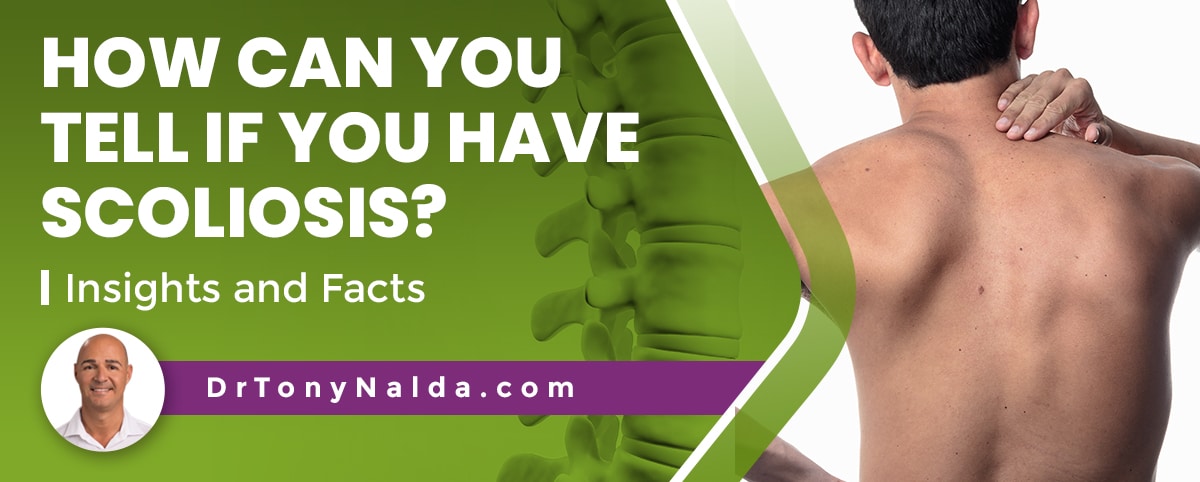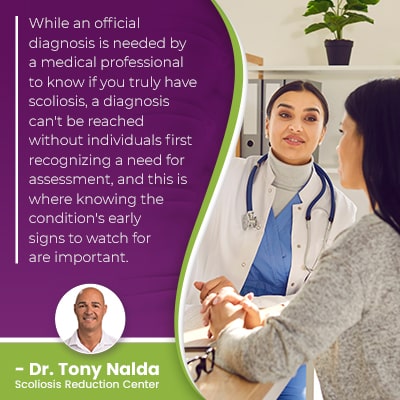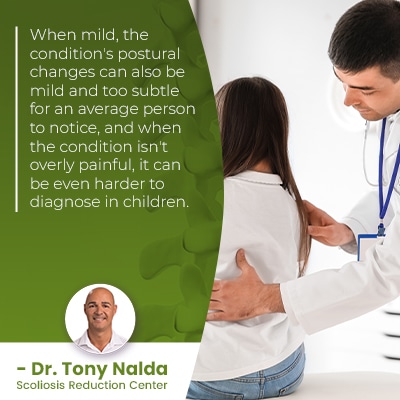How Can You Tell if You Have Scoliosis? Insights and Facts

The facts about scoliosis are that it's a highly-prevalent spinal condition, it's progressive, and it needs to be treated proactively. While there are never treatment guarantees, early detection and intervention is associated with treatment success, so if you think you might have scoliosis, seek medical assessment immediately; getting an early diagnosis can lead to treatment success.
The only way to definitively know if you have scoliosis is to receive an official diagnosis by a medical professional, and this will involve a physical examination and confirmation from X-ray results. Signs of scoliosis to watch for can include changes to posture, balance, coordination, and pain.
The process of being diagnosed with scoliosis is the same for children and adults, but the signs of scoliosis differ among the different age groups, so let's start with how the condition is diagnosed.
Table of Contents
Diagnosing Childhood and Adult Scoliosis
There are a number of spinal conditions that cause a loss of its healthy curves, but scoliosis has some additional characteristics that make it a particularly complex spinal condition.
Scoliosis doesn't just involve the development of an unnatural sideways curvature of the spine, the curve also rotates, making it a 3-dimensional condition.
In addition, scoliosis is also a progressive condition, meaning it has it in its very nature to get worse over time, and this makes it more complex to treat.
Scoliosis can also affect all ages, is the most common spinal deformity amongst school-aged children, and has multiple types with unique causes and treatment needs.
The most common type of scoliosis to affect patients of all ages is called idiopathic scoliosis, and the remaining types are associated with known causes: neuromuscular scoliosis, congenital scoliosis, and degenerative scoliosis.
Scoliosis is most commonly diagnosed in children, and the most common type overall is adolescent idiopathic scoliosis, diagnosed between the ages of 10 and 18.
Scoliosis is diagnosed in children and adults through a combined physical examination and X-ray results that confirm what's truly happening in and around the spine and confirm a patient's Cobb angle; Cobb angle is a measurement needed to reach a diagnosis of scoliosis.
Scoliotic curves have to have a minimum Cobb angle of 10 degrees to be considered a true scoliosis, and the higher a patient's Cobb angle measurement, the further out of alignment the spine is, and the more severe the condition:
- Mild scoliosis: Cobb angle measurement of between 10 and 25 degrees
- Moderate scoliosis: Cobb angle measurement of between 25 and 40 degrees
- Severe scoliosis: Cobb angle measurement of 40+ degrees
- Very-severe scoliosis: Cobb angle measurement of 80+ degrees
So the process of being diagnosed with scoliosis is the same for both children and adults (a physical examination and X-ray results), but the main signs of scoliosis that bring people in for a diagnosis differ between children and adults, so these are important to understand.
Scoliosis Symptoms in Children
 While an official diagnosis is needed by a medical professional to know if you truly have scoliosis, a diagnosis can't be reached without individuals first recognizing a need for assessment, and this is where knowing the condition's early signs to watch for are important.
While an official diagnosis is needed by a medical professional to know if you truly have scoliosis, a diagnosis can't be reached without individuals first recognizing a need for assessment, and this is where knowing the condition's early signs to watch for are important.
As the main type of scoliosis is adolescent idiopathic scoliosis (AIS), let's focus on this age group when discussing childhood scoliosis, and the main effect of scoliosis in adolescents is postural deviation.
When the spine's healthy curves are in place, its vertebrae are aligned as they should be, but when a scoliotic curve develops, some vertebral bodies have become excessively tilted, disrupting the spine's alignment, and this introduces a lot of uneven forces to the spine, its surrounding muscles and nerves, and the entire body.
As a result of the condition's uneven forces, the body's overall symmetry is disrupted, and postural changes are common.
In children, often times, the condition's earliest signs are uneven shoulders and hips, and additional postural changes to watch for can include:
- The head being uncentered over the torso
- Uneven shoulder blades
- The development of a rib cage arch
- An uneven waistline
- Uneven hips
- Arms and legs that appear to hang at different lengths
As a result of the condition's uneven forces, the body's center of gravity shifts, and additional signs to watch for are changes to balance, coordination, and gait.
It's also important to understand that because scoliosis is progressive, it's not a static condition, so where a scoliosis is at the time of diagnosis doesn't mean that's where it will stay; condition effects will become more noticeable the more it progresses.
While noticing postural asymmetries in a child doesn't guarantee a diagnosis of scoliosis, it does indicate the need for further testing, especially considering the benefits of early detection.
Scoliosis Symptoms in Adults
The main difference in the child and adult experience of scoliosis involves progression and pain.
While we don't fully understand what causes the main type of scoliosis to develop (idiopathic), we do know what triggers it to progress: growth and development.
In adolescent idiopathic scoliosis, this age group is the most at risk for rapid-phase progression because of the rapid and unpredictable adolescent growth spurts of puberty, so for adults, the main trigger for progression is removed, meaning progressive rates tend to be slower in adults.
Another key difference between childhood and adult scoliosis is pain; pain is one of the main symptoms of scoliosis in adults, and this can include varying levels of back pain, along with pain that radiates into the extremities due to nerve compression.
Pain in the hands and feet is the most common reason adults come to see me for a diagnosis and treatment.
In children, the constant lengthening motion of a growing spine counteracts the compressive force of the unnatural spinal curve, and it's compression of the spine and its surrounding muscles and nerves that causes the majority of condition-related pain.
When mild, the condition's postural changes can also be mild and too subtle for an average person to notice, and when the condition isn't overly painful, it can be even harder to diagnose in children.
Adults also experience postural changes, particularly a prominent lean to one side, but the most noticeable condition effect is pain.
Scoliosis Treatment Options
 When it comes to scoliosis treatment options, there are two main treatment approaches for patients to choose between: surgical and non operative treatment, also known as traditional and conservative treatment.
When it comes to scoliosis treatment options, there are two main treatment approaches for patients to choose between: surgical and non operative treatment, also known as traditional and conservative treatment.
My patients benefit from a nonsurgical treatment response because I feel this is best for long-term spinal health and function, and conservative treatment is proactive, meaning treatment starts as close to the time of diagnosis as possible and has the goal of working towards preventing progression and the need for invasive spinal fusion surgery in the future.
Scoliosis spinal surgery commonly involves having metal rods attached to the spine with pedicle screws to maintain its position, but this is contrary to the spine's movement-based design, and surgical treatment carries some serious potential risks including nerve damage, muscle weakness, muscle spasms, infection, and excessive blood loss.
In addition, most patients who have had decompression surgery experience a noticeable loss in spinal flexibility and range motion (ROM).
The reality is that many patients with scoliosis don't require surgery, particularly when detected and treated early in the condition's progressive line.
A less-invasive conservative treatment approach preserves as much of the spine's natural strength and function as possible, and I feel this is what gives scoliosis patients the best possible quality of life.
Conservative treatment combines multiple scoliosis-specific treatment disciplines to impact conditions on every level: chiropractic care, physical therapy, corrective bracing, and rehabilitation.
The benefits of early detection are only available to those who respond with a proactive treatment approach, and traditional scoliosis treatment is more reactive than proactive because it doesn't have a strategy for addressing scoliosis while mild.
What I really want patients to understand is that once a diagnosis is reached, the most important decision to be made is what type of treatment plan to commit to.
Conclusion
So how can you tell if you have scoliosis: by seeking assessment from a medical professional who can conduct a physical examination that involves taking a patient's medical/family history, performing an Adam's forward bend test, and interpreting the results of a scoliosis X-ray.
In order to reach a diagnosis of scoliosis, an unnatural sideways-bending curvature of the spine that also rotates and has a minimum Cobb angle measurement of 10 degrees has developed.
While there are never treatment guarantees, early detection and intervention is associated with positive treatment results; the more a scoliosis progresses, the larger the curve gets, the more rigid the spine becomes, making it less responsive to treatment, and the more noticeably the condition affects the body.
The majority of my patients here at the Scoliosis Reduction Center have been diagnosed with moderate scoliosis because in many cases, the signs are too subtle while mild, and it's not until the condition has progressed into the moderate classification that it's noticeable enough to bring patients in for assessment.
In fact, cases of idiopathic scoliosis in adults are actually cases of adolescent idiopathic scoliosis that went undiagnosed and untreated during adolescence, and these cases progress with time and maturity; it's not until scoliosis becomes a compressive condition in adulthood that it becomes painful, and pain is the main symptom of scoliosis that brings adults in to see me for assessment, diagnosis, and treatment.
So the signs to watch for in children are postural changes, a visibly curved spine, and changes to balance, coordination, and gait, and the signs of scoliosis to watch for in adults are pain and postural changes.
Regardless of patient age or condition severity, all cases of scoliosis require treatment, and the best time to start scoliosis treatment is always now.
Dr. Tony Nalda
DOCTOR OF CHIROPRACTIC
After receiving an undergraduate degree in psychology and his Doctorate of Chiropractic from Life University, Dr. Nalda settled in Celebration, Florida and proceeded to build one of Central Florida’s most successful chiropractic clinics.
His experience with patients suffering from scoliosis, and the confusion and frustration they faced, led him to seek a specialty in scoliosis care. In 2006 he completed his Intensive Care Certification from CLEAR Institute, a leading scoliosis educational and certification center.
About Dr. Tony Nalda
 Ready to explore scoliosis treatment? Contact Us Now
Ready to explore scoliosis treatment? Contact Us Now





